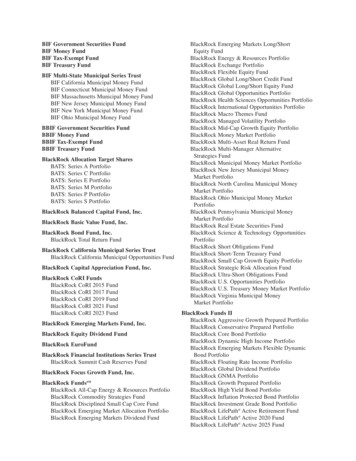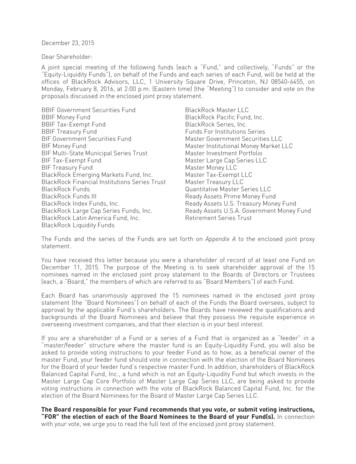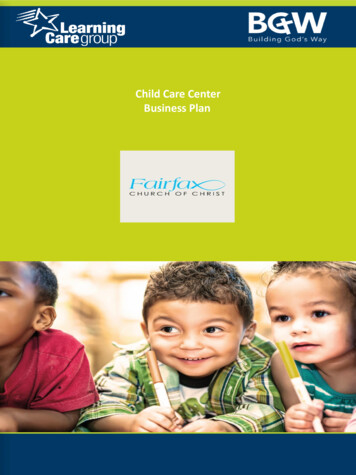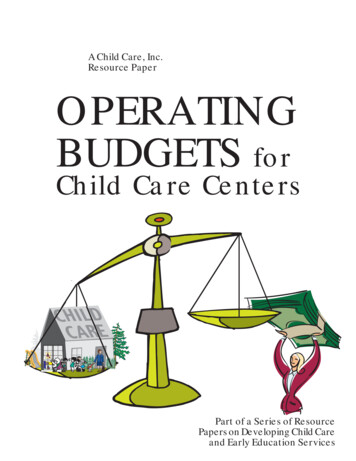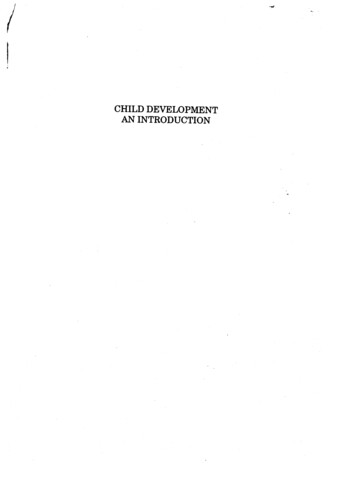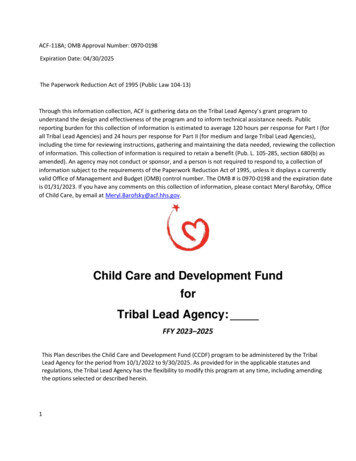
Transcription
ACF-118A; OMB Approval Number: 0970-0198Expiration Date: 04/30/2025The Paperwork Reduction Act of 1995 (Public Law 104-13)Through this information collection, ACF is gathering data on the Tribal Lead Agency’s grant program tounderstand the design and effectiveness of the program and to inform technical assistance needs. Publicreporting burden for this collection of information is estimated to average 120 hours per response for Part I (forall Tribal Lead Agencies) and 24 hours per response for Part II (for medium and large Tribal Lead Agencies),including the time for reviewing instructions, gathering and maintaining the data needed, reviewing the collectionof information. This collection of information is required to retain a benefit (Pub. L. 105-285, section 680(b) asamended). An agency may not conduct or sponsor, and a person is not required to respond to, a collection ofinformation subject to the requirements of the Paperwork Reduction Act of 1995, unless it displays a currentlyvalid Office of Management and Budget (OMB) control number. The OMB # is 0970-0198 and the expiration dateis 01/31/2023. If you have any comments on this collection of information, please contact Meryl Barofsky, Officeof Child Care, by email at Meryl.Barofsky@acf.hhs.gov.Child Care and Development FundforTribal Lead Agency:FFY 2023–2025This Plan describes the Child Care and Development Fund (CCDF) program to be administered by the TribalLead Agency for the period from 10/1/2022 to 9/30/2025. As provided for in the applicable statutes andregulations, the Tribal Lead Agency has the flexibility to modify this program at any time, including amendingthe options selected or described herein.1
For purposes of simplicity and clarity, the specific provisions printed herein of applicable laws and regulations aresometimes paraphrases of, or excerpts and incomplete quotations from, the full text. The Tribal Lead Agencyacknowledges its responsibility to adhere to them regardless of these modifications.2
ContentsContents . 3Introduction and How To Approach Plan Development . 61 Define CCDF Leadership and Coordination With Relevant Systems . 8Tribal CCDF Applicant . 8Designated Tribal Lead Agency . 9Administration Through Contracts or Agreements .10Consultation in the Development of the Tribal CCDF Plan .11Indian Child and Indian Reservation or Service Area .13Child Count .14Types of CCDF Providers .15Coordination of Services .16Program Integrity and Accountability .18Disaster Preparedness and Response Plan .192 Establish Standards and Monitoring Processes To Ensure the Health and Safety of ChildCare Settings . 22Overview of Health and Safety Standards and Monitoring .22Health and Safety Standards and Training Requirements for CCDF Providers .24Monitoring and Enforcement Policies and Practices for CCDF Providers.34Exemptions for Relative Providers .36Comprehensive Background Checks .373 Supporting Continuous Quality Improvement . 53Quality Improvement Goals and Activities .53Supporting Training and Professional Development of the Child Care Workforce WithCCDF Quality Funds .604 Tribal Lead Agencies With Small Allocations Only—Direct Services . 62Direct Child Care Services Offering .623
Direct Child Care Methods .62Categories of Care .63Eligibility Criteria .63Family Contributions/Co-payments .65Payment rates .66Application for services .665 Provide Stable Child Care Financial Assistance to Families (Tribal Lead Agencies WithMedium and Large Allocations) . 675.1 Eligible Children and Families .6767Application and Eligibility Determination/Redetermination Process .74Improving Access for Vulnerable Children and Families.80Family Contribution to Payments .826 Ensure Equal Access to Quality Child Care for Low-Income Children (Tribes with Mediumand Large Allocations) . 86Description of Direct Child Care Services .86Assessing Child Care Market Rates .89Establishing Adequate Payment Rates.89Implement Generally Accepted Payment Practices and Ensure Timeliness ofPayments .927 Promote Family Engagement Through Outreach and Consumer Education (Tribal LeadAgencies with Medium and Large Allocations) . 96Parental-Complaint Process .96Consumer Education for Families, Providers, and the Public .97Monitoring and Enforcement Policies and Practices for CCDF Providers.98Additional Consumer and Provider Education .101Procedures for Providing Information on Developmental Screenings .104Consumer Statement for Families Receiving CCDF Program Funds .1054
Triennial Child Count Declaration.108Triennial Child Count Declaration (P.L. 102-477) .111Tribal Early Learning Initiative .1135
Introduction and How To Approach Plan DevelopmentThe Child Care and Development Fund (CCDF) program provides resources to state, territory, and TribalLead Agencies that enable low-income parents to work or pursue education and training so that they canbetter support their families and can promote the learning and development of their children. The CCDFprogram also provides funding to enhance the quality of child care for all children. On November 19,2014, the Child Care and Development Block Grant (CCDBG) Act of 2014 was signed into law (Public Law[P.L.] 113-186). The law reauthorizes and significantly revises the purposes of the CCDF program andrequirements for states and territories, but Congress left discretion to the U.S. Department of Health andHuman Services (HHS) to determine how the new provisions would apply to Tribes.In September 2016, the CCDF Final Rule was released outlining the regulatory requirements for the CCDFprogram based on the CCDBG Act of 2014. The CCDF program requirements protect the health and safetyof children in child care; help families make informed consumer choices and access information tosupport child development; provide equal access to stable child care for low-income children; andenhance the quality of child care and the early childhood workforce.Tribal flexibility includes tiered requirements based on the size of their allocation: Tribal Lead Agencieswith small, medium, and large allocations. The CCDF Final Rule exempts Tribal Lead Agencies with smallallocations (less than 250,000 in fiscal year [FY] 2016) from the majority of the CCDF programrequirements, allowing those Tribal Lead Agencies more flexibility in how to spend their CCDF programfunds and how to focus those funds on health and safety and quality activities. Tribal Lead Agencies withsmall allocations must spend their CCDF program funds in alignment with the goals and purposes of theCCDF program and must comply with the health and safety, monitoring, background checks, and qualityspending requirements. To align with these limited CCDF program requirements, Tribal Lead Agencieswith small allocations will complete an abbreviated CCDF Plan. This approach balances increasedflexibility with accountability, and allows Tribal Lead Agencies with small allocations to spend their CCDFprogram funds in ways that would most benefit their communities.The CCDF Plan developed by Tribal Lead Agencies is the primary mechanism that the Administration forChildren and Families (ACF) uses to determine Tribal Lead Agency compliance with the requirements ofthe law and Final Rule. This CCDF Plan Preprint consists of two parts, which are aligned with theflexibilities that Tribal Lead Agencies have based on the size of their CCDF allocation.Part I (for Tribal Lead Agencies with small, medium, and large allocations):1) Define CCDF Leadership and Coordination With Relevant Systems2) Establish Standards and Monitoring Processes To Ensure the Health and Safety of Child Care Settings3) Supporting Continuous Quality Improvement4) Tribal Lead Agencies With Small Allocations: Direct Services.Part II (for Tribal Lead Agencies with medium and large allocations only):6
5) Provide Stable Child Care Financial Assistance to Families6) Ensure Equal Access to Quality Child Care for Low-Income Children7) Promote Family Engagement Through Outreach and Consumer Education.These sections reflect key functions of an integrated system of child care for low-income working families.The intention is that Tribal Lead Agencies and the Federal Government will be able to use this informationto track and assess progress, determine the need for technical assistance (TA), and determine compliancewith specific requirements and deadlines.Plan Amendments: Tribal Lead Agencies are required to request approval from OCC through theCARS system whenever a “substantial” change in the Tribal Lead Agency’s approved CCDF Planoccurs. Please refer to the ACF Program Instruction regarding CCDF Approval of Plan Amendments,CCDF-ACF-PI-2009-01, for specific details and timelines specific to the Plan amendment process.Note: All requirements not fully implemented in accordance with CCDF regulations are subject tocompliance actions, such as corrective actions and/or penalties.Tribal Lead Agencies are encouraged to access additional guidance for their CCDF Plans through: Tribal Child Care and Development Fund: Guide for New Administratorso CCDF Final Rule: Overview for American Indian and Alaska Native Granteeso laska-native-granteesChild Care and Development Fund Final Rule Tribal Fact Sheeto rule-tribal-factsheetAdditional questions should be directed to the OCC Regional Office.7
1 Define CCDF Leadership and Coordination With Relevant SystemsThis section provides information on how the CCDF program is administered, including the designatedTribal Lead Agency and administrative structure. It also addresses who was consulted in the developmentof the Tribal CCDF Plan and how the Tribal Lead Agency plans to coordinate CCDF services with otherentities.Tribal CCDF ApplicantTribal Applicant?Tribe or Tribal Consortium Information:Official name of the federally recognized Tribe as listed in the Federal Register or Tribal Consortium:Name of Tribal Chair, President, or Leader:Title:Address:City, State, ZIP Code:Telephone number: ()-Ext:Email address:Tribal ConsortiumTribal Consortiums refer to a partnership between two or more Tribal governments authorized by thegoverning bodies of those Tribes to allow the Tribal Consortium to apply for and receive funding on behalfof the member Tribes.Are you a Tribal Consortium?No (Skip to Section 1.2)YesParticipating Member Tribes/Alaska Native VillagesProvide a comprehensive list of the participating member Tribes/Alaska Native villages and includedemonstrations from the consortium’s participating Tribes indicating that the consortium has theauthority to seek funding on their behalf. Each consortium member must provide a demonstrationevery three years for the consortium Lead Agency to include with the plan submission. The purpose ofthe demonstration is to show that the member has authorized the consortium Lead Agency to act onits behalf.8
Examples of demonstrations include a Tribal Resolution, a letter signed by the current Tribal Leader,or another official document from the Tribal/village government (98.80(c)(1-4); 98.81(b)(8)(i)).For Alaska Native Regional Nonprofit Corporations, the list and demonstrations are for purposes ofdiscretionary funds only.Confirm the consortium members:***The CARS system will prepopulate consortium members from FY 2020 child count. Tribal LeadAgency should confirm each tribe listed is currently a member and update with any changes.The current demonstrations are provided as Attachment #:If there is any change in the consortium membership, the Tribal Lead Agency must notify OCCthrough an amendment to the Plan. Any consortium member Tribe seeking to apply for its own CCDFgrant funds must first withdraw from the Tribal Consortium and contact OCC to initiate a separateapplication for its own funds. OCC must receive the application on or before July 1 prior to the year inwhich the Tribe is seeking CCDF program funds.Coordinated Services on behalf of participating member Tribes/VillagesA Tribal Consortium must describe how it coordinates services on behalf of each of its participatingmember Tribes/villages.Summarize how the consortium is coordinating services (including direct services) on behalf of eachparticipating member (98.81(b)(8)(ii); 98.83(c)(1)).Describe how child care services are provided to each member of a Tribe/village:Designated Tribal Lead AgencyThe Tribe or Tribal Consortium will designate an agency to represent the Tribe/consortium as the Tribal LeadAgency. This designated agency agrees to administer the Tribal CCDF program in accordance with applicableFederal laws and regulations and the provisions of this Plan, including the attached assurances andcertifications (658D; 658E(c)(1); 98.83(a)).The Tribal Lead Agency can be a department or sub-agency, such as the CCDF department, human servicesdepartment, workforce development department, and in some cases, the Tribe will administer the CCDFprogram.Note: An amendment to the CCDF Tribal Plan is required in the event of a change in the designated TribalLead Agency.Designated AgencyDesignated Agency by the Tribe or Tribal ConsortiumWhich agency has been designated by the Tribe or Tribal Consortium to administer the CCDFprogram?9
Name of Tribal Lead Agency:Web address for Tribal Lead Agency (if any):Tribal CCDF AdministratorIdentify the CCDF Administrator designated by the Tribal Lead Agency, the day-to-day contact person, orthe person responsible for administering the Tribal CCDF program. If there is more than one designatedcontact person with shared responsibility for administering the CCDF program, please identify the CoAdministrator/Assistant Administrator and include relevant contact information.Contact information for the Tribal CCDF Administrator:Name of Tribal CCDF Administrator:Title:Mailing address:Physical address (if different than mailing address):Phone number: ()-Cell phone number: (Ext:)-Email address:1.2.2.2 Contact Information for Tribal CCDF Co-Administrator/Assistant Administrator (if applicable):Name of Tribal CCDF Co-Administrator/Assistant Administrator:Title:Mailing address (if different from above):Physical address (if different than mailing address):Phone number: (Cell phone number: ())Ext:-Email address:Administration Through Contracts or AgreementsThe Tribal Lead Agency has broad authority to administer the CCDF program through contracts oragreements with other governmental, non-governmental, or other public or private local agencies. TheTribal Lead Agency remains the single point of contact and retains overall responsibility for theadministration of the CCDF program (658D(b)(1)(A); 98.11(a)(3); 98.16(d)(1)). Examples of such agreementscould include:10
A written agreement with another Tribal department to operate Tribal child care centers or to conducttraining and monitoring A contract with a local agency to operate the Tribal Lead Agency’s child care program (includingdetermining family eligibility and issuing payments to child care providers or providing high-qualityactivities).Direct Administration and OperationAdministration and operation of the CCDF ProgramWill the Tribal Lead Agency directly administer and operate the CCDF program (98.16(d)(1))?This question does not apply to the demonstrations referenced in Section 1.1.2 between a consortiumand its participating/constituent member Tribes/villages.Yes, the Tribal Lead Agency will directly administer and operate all aspects of the CCDF program.No, the Tribal Lead Agency will not directly administer and implement all aspects of the CCDFprogram.Names of entities that will administer and/or operate aspects of the CCDF programList the names of those entities that will administer and/or operate aspects of the CCDF program anddescribe which aspects of the CCDF program they will administer and/or operate. List and describe:1. What processes will the Tribal Lead Agency use to monitor administrative and implementationresponsibilities performed by other agencies? Describe:2. Optional: Include copies of the contracts or agreements as Attachment #:Consultation in the Development of the Tribal CCDF PlanIn the development of the Tribal CCDF Plan, the Tribal Lead Agency is required to consult withrepresentatives of general purpose local/ Tribal government (658D(b)(2); 98.10(c); 98.14(b)). Tribal LeadAgencies are also required to conduct a public hearing to provide an opportunity to comment on theprovision of the child care services under the CCDF Plan (98.14(c)). For the purposes of developing this Plan,consultation involves meeting with, or obtaining input from, appropriate representatives of the Tribalcommunity.Consultation and RepresentationEntities Consulted by Tribal Lead AgencyDescribe how the Tribal Lead Agency consulted with representatives of general purpose local andTribal governments, and any other entities in the development of this plan. Describe:11
Public HearingsTribal Lead Agencies are required to conduct a public hearing to provide those interested with anopportunity to comment on the provision of child care services under the CCDF Plan (658D(b)(1)(C);98.14(c)(1-3); 98.16(e)).The Tribal Lead Agency must conduct at least one public hearing prior to the submission of the TribalCCDF Plan but no earlier than January 1, 2022. The Tribal Lead Agency must provide a notice of thehearing throughout the Tribe’s service area. This notice must be provided no later than 20 days prior tothe date of the hearing. Tribal Lead Agencies must make the contents of the Plan available to the public inadvance of the hearing.Describe the Tribal Lead Agency’s public hearing process by responding to the questions below:Date(s) of public hearing notice(s) (at least 20 calendar days prior to the public hearing):Date(s) of public hearing(s) (no earlier than January 1, 2022):Location(s)/ of the public hearing(s), including virtual:How was the public notified of the public hearing? Check only those that apply:Family newsletterTribal/local mediaInternet—provide website(s):Social media (e.g., Facebook, Twitter)Posting on community bulletin board or some other message boardOther. Describe:Input from the public hearing(s) in the development of the final Plan.Describe how the input from the public hearing(s) was taken into consideration in the development ofthe final Plan:No input was received.Input was incorporated into the plan in the following ways:.Other. Describe:Content of the Plan available to the service area prior to the public hearing.How was the content of the Plan made available throughout the service area prior to the publichearing? Check only those that apply:12
Tribal offices (including CCDF offices).Internet. Provide website(s):Email.Other. Describe:Plan Availability to the PublicTribal Lead Agencies with small allocations are not required to make the final CCDF Plan or anysubsequent Plans available to the public but have the flexibility to describe if applicable.Tribal Lead Agencies with large and medium allocations should post their Plan and Plan amendments ona website to the extent practicable.Final CCDF Plan and Plan Amendments available to the public.Describe how the Tribal Lead Agency makes the final CCDF Plan and any subsequent PlanAmendments available to the public to the extent practicable:Indian Child and Indian Reservation or Service Area (AUTO FILLED FROM APPENDIX 1 SUBMISSION)Identify which Indian child(ren) are counted in the Tribal Lead Agency’s child count (98.81(b)(2)(i)).Indian ChildPrograms and activities are to be carried out for the benefit of Indian children.Although Tribal Lead Agencies have some flexibility in defining “Indian Child,” the definition must belimited to children from federally recognized Indian Tribes, consistent with the CCDBG Act’s definition ofIndian Tribe (98.2).This information could include children who are Tribal members, whose membership is pending, who areeligible for membership, and/or are children/descendants of members and could also include adoptedchildren, foster children, step-children, etc.The Tribal Lead Agency defines an “Indian child” as:Indian Reservation or Service AreaPrograms and activities are to be carried out for the benefit of Indian children living on or near the Indianreservation or service area. The service area must be within reasonably close geographic proximity to theborders of a Tribe’s reservation (except for Tribes in Alaska, California, and Oklahoma). Tribes that do nothave reservations must establish service areas within reasonably close geographic proximity to the areawhere the Tribe’s population resides.13
There is an expectation that the Tribal Lead Agency will be able to provide services to families throughoutthe service area. ACF will not approve an entire state as a Tribe’s service area. Tribal Lead Agencies canlimit services within the reservation boundaries or go beyond the reservation boundaries.If a Tribal Lead Agency establishes a different service area than the borders of the Tribe’s reservation orexisting service area for CCDF purposes, it must be within reasonably close geographic proximity(658O(c)(2)(B); 98.80(e); 98.81(b)(2)(ii); 98.81(b)(3)(ii); 98.83(b)); for example, “Permanent residence iswithin the reservation boundaries; however, the participant is temporarily attending school outside of thereservation area,” or “[the participant] resides within 20 miles of the reservation boundaries.”The Tribal Lead Agency defines the Reservation/Service Area as:Optional: Attach a clearly labeled map of the serviceOptional: In addition to the description above, a clearly labeled map of the service area is attached.Attachment #:Child CountFor the purposes of determining a Tribe/Tribal organization’s annual CCDF program funding level, theTribal Lead Agency is required to conduct and submit a triennial child count of children younger thanage 13, as defined in 98.81(b)(2)(i). The Child Count Declaration will be submitted every 3 years with thetriennial Plan. For the FY 2023 – FY 2025 Plan period, the child count must be submitted by July 1, 2022.For new Tribal Lead Agencies entering outside the Plan cycle, the child count will be submitted with theirCCDF Plan.The Tribal child count will be effective from October 1, 2022, to September 30, 2025, and will be valid for3 years. If the consortium gains or loses one of its member organizations, then the adjustments will bemade accordingly.The Tribal Lead Agency may not count any children who are included in the child count of another CCDFTribal Lead Agency. The Tribal Lead Agency is required to confer with all other CCDF Tribal LeadAgencies that have overlapping or neighboring service areas (98.61(c); 98.62(c); 98.80(b(1); 98.81 (b)(4)).The child count submitted is not reflective of the number of children who receive direct services. Instead,the child count gives the number of potentially eligible children who meet the Tribal Lead Agency’sdefinition of Indian Child, and who reside in the designated service area.Tribes that operate under an approved P.L. 102-477 Plan shall submit their triennial child counts ofchildren younger than age 13 by July 1, 2022. The child counts will be effective from October 1, 2022,through September 30, 2025. Complete the “Child Count Declaration” at Appendix 1-A. The form alsorequests P.L. 102-477 Tribes that would like to make a request for reallotted Tribal discretionary funds toindicate that by checking “yes” or “no” if these funds become available.14
Adjacent and Overlapping Service AreasAdjacent and Overlapping Service Area(s) of other Tribal Lead AgenciesIs the service area (as defined in 1.5.2) adjacent to, or overlapping with, the service area(s) of anyother Tribal Lead Agencies?NoYesIdentify those other Tribal Lead Agencies with neighboring or overlapping service areas.Describe:Describe the Tribal Lead Agency’s process for ensuring unduplicated child counts for thisoverlapping service area:Child Count DeclarationComplete the “Child Count Declaration” at Appendix 1.A Tribal Consortium must submit an individual Child Count Declaration, signed by an individual authorizedto act for the Tribe, for each participating Tribe; a summary listing the name of each participating Tribe;each participating Tribe’s individual child count; and the total child count for the entire consortium.A “Child Count Declaration” is attached at Appendix 1.Types of CCDF ProvidersThe Final Rule established three categories of care: Center-based child care: Group care provided in a facility outside of the child’s or provider’s home Family child care: Care provided in a private residence other than the child’s residence In-home child care: Care provided in the child’s homeTribal Lead Agencies have flexibility in the types of child care providers that offer direct care to families andchildren. For example, a Tribal Lead Agency may provide direct child care services through a Tribally OperatedCenter, or a Tribal Lead Agency with a small allocation may not offer direct services at all. In addition, TribalLead Agencies may choose to regulate child care providers through a state licensing agency rather than aTribal agency.Providers That Offer Direct ServicesTypes of providers offering direct services to families and children.Select the types of providers that offer services directly to families and children in the Tribal CCDFProgram. The following list includes some variation in describing the types of direct service providers in15
the Tribal CCDF program, but additional sections will refer to the three categories of care. Check onlythose that apply:Tribally Operated Center(s)Tribally regulated (or licensed) center-based providers (not operated by the Tribal Lead Agency)Tribally regulated (or licensed) family child care providersState-licensed center-based providersState-licensed family child care providersLicense-exempt center-based providersLicense-exempt family child care providersRelative care providers over age 18In-home providers (care in the child’s home)This Tribal Lead Agency does not offer direct services to families through the Tribal CCDF Program.(Only Tribal Lead Agencies with small allocat
flexibilities that Tribal Lead Agencies have based on the size of their CCDF allocation. Part I (for Tribal Lead Agencies with small, medium, and large allocations): 1) Define CCDF Leadership and Coordination With Relevant Systems 2) Establish Standards and Monitoring Processes To Ensure the Health and Safety of Child Care Settings




